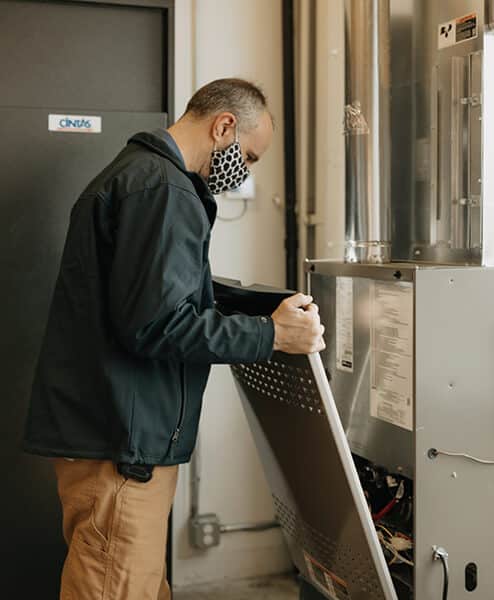16 Basement Heating Options for Your Home

If you live in an old Lynnwood, WA, home with a basement, as many of us do, there’s always the question of what to do about heating. Should you use space heaters? If so, how do you make sure they’re safe? Should you use a central heating system like a furnace, radiator, or air conditioner? We go into detail about the best heating options for basements.
1. Space Heaters for Basements
Space heaters can be an effective heating solution for a basement if you choose the right one for your situation and use it correctly. They’re less likely to burn down your house than a central heating system is, so if you want to do something low-cost or with minimal effort, this is an excellent way to solve the problem of the basement being cold. Some of these heaters are also portable so that you can move them with you.
2. Radiators for Basements
If you’re renting an old house, replacing the central heating system might not be possible, or you may want to save money by not having your landlord pay for it. Or perhaps your building inspector says that installing a radiator is sufficient. When it comes to replacing an older furnace, options are more limited. You can get a portable radiator that can be moved from room to room, but you also have the option of using a radiant heat system.
3. Heating for Basements With Fireplaces
A fireplace is another option for heating basements, especially if the wall is thick enough. The issue here is that many of them are not safe to use in any building, so some steps are involved in maintaining them. It’s worth considering if the amount of heat the fireplace provides is sufficient for your needs, and you’ll want to make sure that it doesn’t pose a fire risk. For heating installation in your basements, contact Brennan Heating & Air Conditioning.
4. Concrete Heaters for Basements
Concrete heaters are an exciting option for heating basements because they don’t seem to work in the same way as other heat sources. They’re a good option for those who don’t want to install a separate device, as it allows you to use any surface as a heat source. In terms of safety, it’s also not advised that those with little experience use them.
5. Fireplaces and Hot Tubs for Basements
Another popular choice is having a fireplace and hot tub in the basement. This combination is almost always out of the realm of possibility for cities that don’t allow these two things to be used together safely. Still, people who live in areas with fewer restrictions may like this option. It’s less useful in the winter, but it can still help you save on your energy costs during the summer months. It’s also a space that can be used for entertaining during those hot days.
6. Heating a Basement With a Furnace
A furnace can be used to heat a basement if it’s not too large. However, many cities and counties still prohibit this kind of installation, so you’ll want to check with them and get permission. It’s also no longer an option in most homes that have central heating systems. It does work for those who have radiant heat installed in their home, however.
7. Electric Radiant Heating System
A radiant heating system is another option for heating basements, but the most common one that works is electric. They work well for keeping the whole room at a constant temperature, which is what you’ll need if you’re trying to maintain a room in your basement. It doesn’t do much good to keep the temperature at 72 degrees if it’s only 72 there and colder everywhere else. You also have the benefit of being able to adjust it with remote control devices.
8. Oil Radiant Heating System
Oil radiant heating systems are a bit more common in homes that were built before the 1950s. It works by using a furnace to heat an oil-filled radiator, which then heats other rooms in the house. It takes a bit longer to heat up than some different types of heating, so you’ll want to set your temperature lower and allow time for it to spread throughout the home.
9. Electric Heat Pump System
Heat pumps are another option for heating basements. They’re becoming more popular because they don’t require ductwork while still providing the same kind of heat distribution that other systems do. They also offer better heating through the thick walls of older homes.
10. Water-Filled Radiators for Basement
Perhaps the most out-of-the-box option for heating a basement is to use a water-filled radiator. Water is a great thermal conductor, which means it can spread heat from one spot to another without using ductwork. This doesn’t mean that you shouldn’t have some system that distributes the water around, but it can provide enough heat with this method if your basement isn’t too big.
11. Radiant Barrier System
A radiant barrier system is used to insulate basements without using an existing heating system. It’s best used in areas that don’t get all that cold. It works by building up the insulating value of foam insulation to block out heat, so it doesn’t work as well in the winter. You can find this online or at a home improvement store.
12. Radiant Barrier System With a Furnace
Another option for heating basements is using a radiant barrier system and a central heating system together. This allows you to have a constant temperature throughout the home. You can also use it with a fireplace, for example, so you’ll have warm air when you want it and a fire in your fireplace when you want that.
13. Hydronic Heating System for Basements
A hydronic heating system works by sending hot water through pipes to the radiator. It’s similar in some ways to a radiant heating system, but it can be much more complicated. It’s also one of the most expensive options, so you’ll want to make sure it’s the right one for your situation. Some people like having radiant heat because it keeps them warm even when they’re not near any radiators.
14. Hydronic Heating System With a Pipe Distribution System
A pipe distribution system allows you to have a hydronic heating system. Connecting the pipes to the water lines makes it easy to get hot water through your home without going through radiators. While you get all of the benefits of radiant heat, this will still get rid of cold spots in your home.
15. Electric Hydronic Heating System
Another good option for heating basements is using an electric hydronic heating system. It works by using electricity from a central source to heat a bathroom or a whole house. Much of the benefit is that it doesn’t require a lot of ductwork, so you’ll have less to worry about.
16. Direct Vent Gas Heating System for Basements
A direct vent gas heating system is another option, but it does have a lot of requirements before you can have it installed in your home. It’s for those who need a lot of heat and who use a lot of hot water. It’s also a popular choice for those who live in colder environments, as it heats up quickly and maintains the temperature well through the night.
Using these tips, you’ll be able to find the right kind of basement heating for your Seattle, WA, home. Our technicians are more than happy to help you find the best one. For AC repair and installation, water heater repair, and air duct cleaning, contact Brennan Heating & Air Conditioning today.







